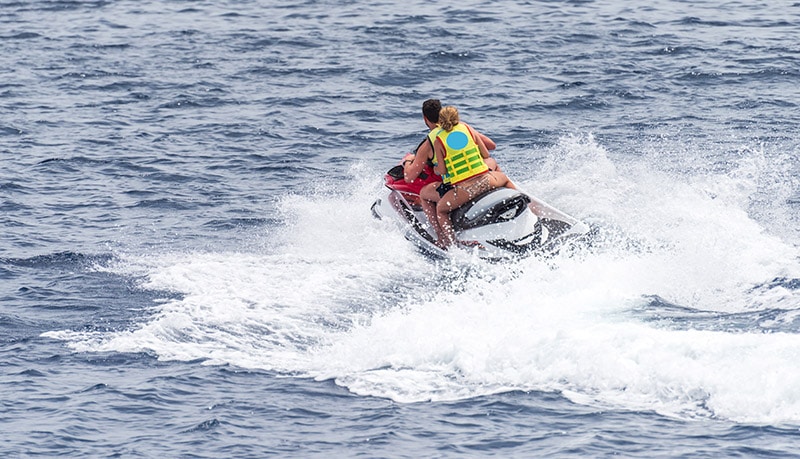Riding a jet ski is a favorite activity for many water sports enthusiasts.
Hitting the waves and gliding across the water at rapid speeds brings a shot of adrenaline for anyone onboard.
You can ride a jet ski on any large body of water, whether it’s an ocean, lake, or large river.
Where and when you go riding will determine what you should wear when you go jet skiing; this includes seasonality, elevation, time of day, and weather conditions.
Whether you’re renting a jet ski for a few hours or plan on purchasing your own personal watercraft (PWC), appropriate attire is something to think about.
Here, we’ve gathered our list of clothing and accessory options for those who want to become jet ski enthusiasts (or even just hang out on one for a day).
What Do You Wear on a Jet Ski?
First things first, since jet skiing is an outdoor water sport, it only makes sense that you would wear appropriate, water-friendly clothing.
The bare minimum of what you should wear while riding a jet ski include:
- Bathing suit or swimsuit/swim shorts (though we don’t recommend this for longer, faster rides)
- PFD, or personal flotation device (a jet ski vest or life jacket)
- Sunscreen/sunscreen chapstick

For longer, more intense rides we recommend adding:
- A swimsuit cover up or long-sleeve sun shirt
- A tight-fitting hat (or, even better, one that ties on) with a decent brim
- Sunglasses secured with a strap (or goggles)
In colder weather, we suggest:
- A wetsuit
- Neoprene boots
- Gloves
The Best Jet Ski Clothes
Now that we’ve told you the minimum of what you should wear on a jet ski (PWC), let’s break it down so you can make the best decision for your next jet ski adventure.
Bathing Suit or Swimsuit
We know it’s a little “Captain Obvious” to suggest wearing a swimsuit for a water sport, but the point here is that you are very likely to get wet while riding a jet ski (especially when going fast), so you need to wear clothes you don’t mind getting wet in.
But there’s more to waterwear than just soaking up some stray droplets.
The key here is mobility.
While it hopefully never comes to pass, a personal watercraft can capsize, you can fall off, and you need to be able to maneuver in the water if you do.
That means staying away from dresses (or long cover ups), tight shorts, or anything else that hinders your ability to swim.
Men’s traditional swim trunks with elastic waistbands are great for both mobility and staying on a jet ski.
While traditional women’s swimsuits will work (and be fine for mobility), they can make staying on a jet ski seat more difficult.
When a PWC seat gets wet, it gets slippery. More fabric means more friction, which helps keep you from sliding.
Due to this, we recommend swim shorts over a traditional bathing suit for women.
PFD (Jet Ski Vests / Life Jackets)
Not all states require PFDs for adults on personal watercraft (though, some do and almost all have PFD laws for children), but there is zero reason why you shouldn’t wear one no matter where you’re doing your jet skiing.
U.S. Coast Guard Laws require you to carry a PFD onboard for every passenger anyway.
If you plan to rent a jet ski, chances are a PFD comes as part of the package and wearing it is required as part of your rental agreement.
In case of accident or emergency, a PFD can literally make the difference between life and death.
And, if you plan on jetskiing with your dog, don’t worry, they’ve got PFDs for the dog too!
When you’re shopping for PFDs, use the PFD manufacturer’s guidance on sizing.
Having a properly-sized PFD is just as important as having a PFD at all.
If it’s too big, your PFD will be ineffective. If it’s too small, it will impede movement.
Always try a PFD out in shallower water before hitting the deeps.
Sunscreen
Riding a jet ski puts you out on wide-open water about 99% of the time.
That means, it puts you in the direct line of the sun.
Before you leave shore, sunscreen up.
And don’t forget to protect your lips with sunscreen chapstick.
Even when it looks cloudy.
You may not notice them as much, but those powerful UV rays can shoot right through the clouds, doing damage to your skin.
Strong sun can burn you in less than ten minutes, so sunscreen is a necessity even on short jet ski rides.
To protect marine life in the ocean, always opt for reef-safe sunscreen.
Or, better yet, just cover up.
Sun Shirts, Hats and Sunglasses
While you’ll be safe on a PWC in proper swimsuit bottoms, well-applied sunscreen, and a PFD, if you’re prone to burning, heat exhaustion, or any other sun-related issues, we highly suggest a bit more cover on a jet ski.
Especially if you plan to be out on the water for an extended period of time.
- A swimsuit cover up (keep it short) or long-sleeve sun shirt can prevent sunburns.
- A hat with a brim (just make sure it’s secure) keeps the sun off your face, preventing sunburn and protecting your eyes.
- Sunglasses help you see on the water and also protect you from the sun’s glare.
Of these items, sunglasses are the most essential.
Wearing sunglasses on a jet ski isn’t simply a matter of comfort; it’s a matter of safety.
Getting blinded by the sun’s glare can cause accidents.
If you wear prescription glasses, it’s highly recommended you get a pair of prescription sunglasses (or, better yet, sporting goggles) for jet ski riding.
Non-prescription goggles are also available for any rider who wants a little more secure protection from the sun.
What Do You Wear on a Jet Ski When It’s Cold?
One benefit of a jet ski is that it allows you to enjoy the water at almost any time of year.
The only question is whether or not you’ll be comfortable doing it.
There’s no reason you shouldn’t be.
There is plenty of winter water wear expressly designed for enjoying time on (or even in) the water, despite plummeting temperatures.
Jet Ski Wetsuit
Wetsuits are the quintessential waterwear for any winter water activity.
Designed to be comfortable and keep you mobile, they provide the greatest possible protection from cold waters, as well as the sun.
If temperatures aren’t quite that cold yet, but still too cold for swim shorts (think late spring/early fall), you can also pair a rash guard with a pair of swim leggings.
You’ll get similar results to a wetsuit in slightly more breathable fabrics.
Jet Ski Shoes
Many jet ski riders choose to ride barefoot.
That’s all well and good as long as you’re on the jet ski and nothing unexpected happens.
But if you plan to get off in the water or ride fast, you need water shoes. And you’ve got a few options from which to choose.
You can get neoprene surf boots, which are great for sun and temperature protection, but not so great for walking on rocks, or hard-soled water shoes, which are great for protection from rocks and other objects, but not so great at keeping your feet warm.
Jet ski riding boots combine both.
They are enclosed and relatively warm compared to most water shoes, and have hard soles, offering both temperature protection and protection from sharp objects.
These shoes are specifically designed to prevent slippage and injuries to the ankle from impact with the hull when riding fast.
Keep that in mind when looking at water shoes.
If you’re going to take your PWC to top speeds, you’ll want some ankle protection too.
Jet Ski Gloves
Jet ski gloves aren’t just for winter.
They come in both full-fingered and fingerless varieties, and provide a better grip on a PWC’s handles at any time of year.
That said, jet ski gloves are a necessity come winter.
Things always feel colder out on the water, and cold hands are impaired hands.
Like a wetsuit, jet ski gloves are made of neoprene and keep your hands both warm and dry.
Wrapping it Up
Any day out on a jet ski is a good day in our books.
Assuming you don’t come home with a sunburn and pains, regretting the clothing choices you made on the water.
When preparing for a day out on your PWC, be stylish, but be sensible.
And, whatever you do, don’t forget the sunscreen!
